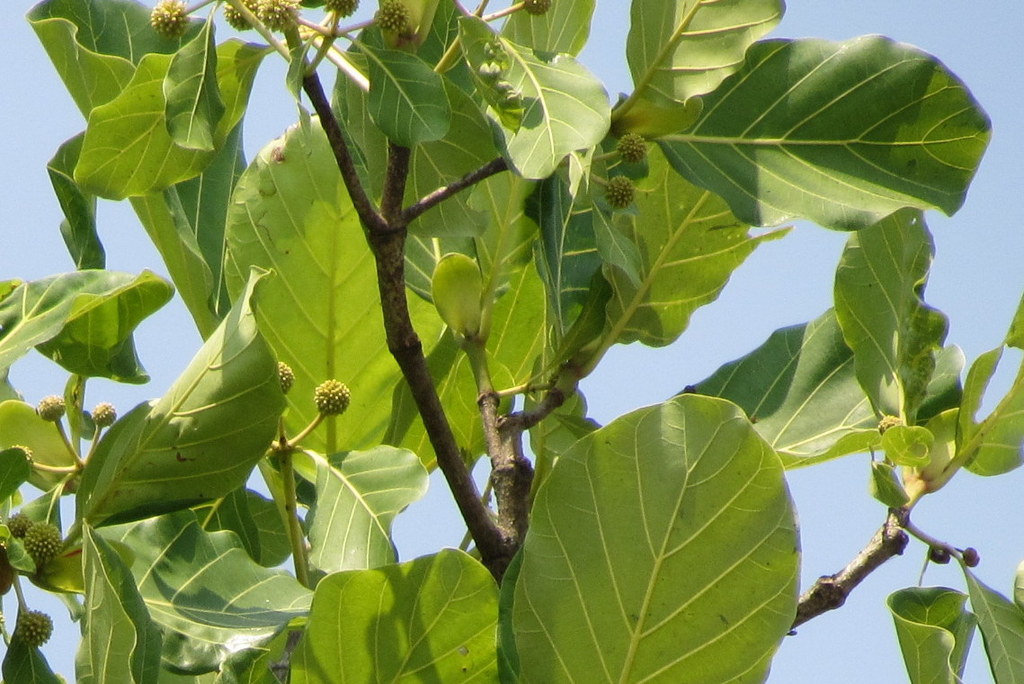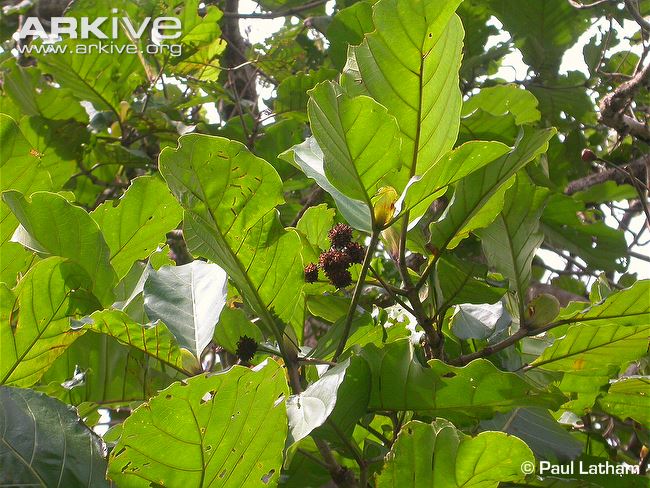Hallea stipulosa (DC) Leroy
| Botanical Name | Hallea stipulosa (DC) Leroy |
| Order: | Gentianales |
| Family: | Rubiaceae |
| Genus: | Fleroya |
| Species: | F. stipulosa |
| Common Names: | African linden, Abura (English); Tilleul d'Afrique, Bahia (French) |
Plant Synonyms
Fleroya stipumosa (DC) Y.F. deng,
Mitragyna sipulosa (DC.) Kuntze,
Nauclea stipulosa DC.
Nauclea macrophylla Perr. & Lepr. ex DC.,
Nauclea bracteosa Welw.,
Mitragyna chevalieri K.Krause
Plant Local Names
Ghana: Akan - Subaha akoa, Nzema – Baya
Guinea Conakry: Pular - Maninka kouranko, Popo - Soussou fofe, Kissi - Pawe
Liberia: Kru - Boh
Senegal: Diola - Bubagala
Plant Habitat
Species growing in areas periodically flooded, savannahs and near temporary ponds. Occurs in tropical Africa (Guinea, Mauritania, Senegal, Cameroon, Chad, and Sudan).
Plant Material of Interest
Stem bark and leaf
Plant Description
Tree up to 15 - 20 m tall and .cylindrical shaft without buttresses up to 1 m in diameter; bark, very thick and scaly, dense crown with several tufts; leaves simple, opposite, slightly leathery, elliptic, broad, and measuring 10 to 50 cm long; tap root system; spike inflorescence composed of numerous small globular flowers. Tight white calyx; fruit small spherical capsules.
Plant Used Parts
Plant Uses
In Cote d’Ivoire, the bark is prescribed for the treatment of gonorrhoea (Bouquet and Debray, 1974). In Guinea, the decoction of the stem bark is used as a diuretic, antiseptic and anti-infective; the infusion is used in the treatment of female infertility and the leaves as a topical antiseptic for wounds. In Ghana, the decoction of the dried stem bark, administered orally is very effective against guinea worm (Comley, 1990). The decoction is used to treat malaria in adults, while the bark is used for the treatment of genital, urinary and worm infestations.
Plant Therapeutic Action
Antimalarial, antibacterial
Plant Precaution for Use
Do not exceed the recommended doses
Plant Adverse Effect
Large doses may cause gastrointestinal disturbances
Plant Contraindication
Pregnancy and lactation
Plant Dosage Forms
Decoction: 30 g of dried plant material in 900 ml water; boil until reduced to 600 ml; two tablespoonful three times daily. '
Plant Dosage
Decoction, infusion
Plant Storage
Store in a cool dry place
Plant Chromatographic Fingerprint
Plant Constituents
Many triterpenes were isolated from the plant including α-amyrin, quinovic acid—3-0-β-D-quinovopyranoside-27-O-β-D-glucopyranosyl; quinovic acic, ursolic acid, quinovin C glycoside, acid-3-0-acety-β ursolic: quinovic-acid-3-0-β-D-glucopyranoside; oleanolic acid; zygophyloside B, zygophyloside D, daucosterol.
Plant References
Adjanohoun, E., Ahyi, M.R.A., Ake Assi, L. et al. (1974). Contribution aux etudes ethnobotaniques etfloristiques en Republique populaire du Congo. Agence de cooperation culturelle et technique, (A.C.C.T.), Paris, 605 p., (1988) A partir de la banque de donnees Pharmel 2 (ref. HP 10).
Akinsinde, K.A., Olukoya, D.K. (1995). Vibriocida activities of some local herbs. Journal of Diarrhoeal Diseases Research 13 (2):127-129.
Bouquet, A., Debray, M. (1974). Plantes medicinales de ia Cote d'lvoire.Travaux et Documents de I'ORSTOM., Paris, n 32, 232 p.
Comley, J.C.W. (1990J. New - macrofilaricidal leads from plants; Tropical Medical Parasitology 41 (1 ):1 -9
Fatima, N., Tapondjou, L.A., Lontsi, D., Sondengam, B.L. et al. (2002). Quinovic acid glycosides from Mitragyna stipulosirst examples of natural inhibitors of snake venom Phosphodiesterase i. Natural Product Letters 16(6):389-393.
Kohler, I., Jenett Siems, K., Kraft;C., Siems, K. et al. (2002). Herbal remedies traditionally used against malaria in Ghana: b'ioassay-guided fractionation of Microglossa pyridolia (Asteraceae) Z Naturforsch ser C 57C (11/12):1022-1027.

